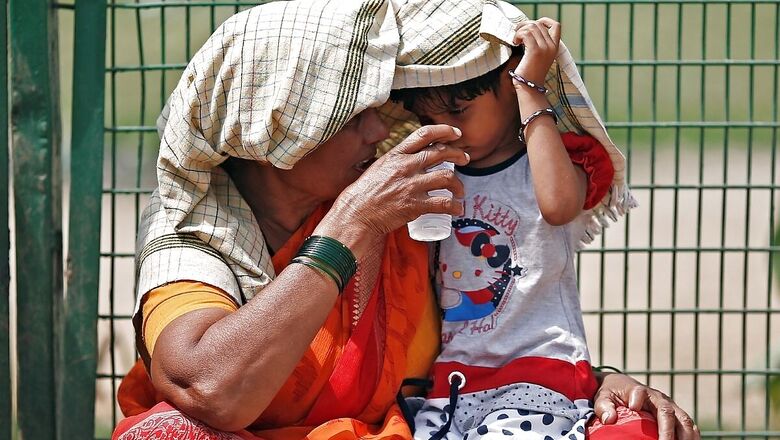
views
Trouble boils and bubbles in northern and other parts of the country as the regions turned into ‘cauldrons’ in March. Delhi recorded a mean maximum temperature of 33.1 degrees Celsius this month, making it the hottest March in the last 11 years, the India Meteorological Department said on Wednesday.
The north Indian plains have been reeling under a heatwave. The IMD said the region is likely to get some relief over April 1 and 2, but the reprieve will, however, be short. The weather body warned of another heatwave over the plains by April 3.
As temperatures rise, here’s all we know about the heatwave, its causes, and ways you can protect your body amid it:
Heatwave: What to Expect and Causes?
☼ What’s Happening this Year? This time, the heatwave is being reported in a very wide area covering east, central, and northwest India in March. The phenomenon is occurring quite early this year as heatwaves have occurred in April for the past ten years. Prior to that, they appeared to begin in May. However, very high temperatures were reported in March this year as well, owing to a lack of rainfall and extremely dry weather.
☼ Mercury Runs High: Over the last 4-5 days, the mercury has touched over 40 degrees Celsius in several parts of north India, especially Rajasthan. The national capital reeled under a “severe” heatwave on Monday as the maximum temperature shot up to 40.1 degrees Celsius, making it the hottest day in March in 76 years.
☼ Pressure Variations, Transfer of Heat: IMD Director General Mrutunjay Mohaptra said there was pressure variation between the area stretching from the Gujarat coast to Haryana. Plus, there was transfer of heat from Rajasthan which was already reeling under the heatwave. This led to the heating of plains. Naresh Kumar, senior scientist with the IMD who specialises in heatwaves, said the transfer of heat was also from Pakistan. He said one of the weather stations in Pakistan also recorded 45 degrees Celsius during the same time. Experts have also said that high temperatures in the month of March this year can be attributed to absence of strong western disturbances (WDs) in the last 15 days. Five WDs affected the plains of northwest India this month, of which four were in the initial 15 days.
☼ Experts Say Global Warming May be a Cause: Experts have also claimed that the heatwave may due to the Arctic region warming up like never before and at an alarming rate with temperatures increasing more than twice as fast as the global average. A report by the Hindu says the warming of the Arctic, or rising surface temperatures, is a result of “global warming,” according to a recent study involving researchers from India and Brazil, titled “Large-scale Connection to Deadly Indian Heatwaves.” The research has shown for the first time that heat waves will occur in India as a result of a mechanism called “Quasi-Resonant Amplification (QRA)”, which is caused by Arctic warming as a result of global warming.
☼ Deadly Heatwaves to Become Common? Potentially deadly heat waves will likely become more commonplace in South Asian countries, including India, in the coming decades even if global warming is limited to 1.5 degrees Celsius, according to a new study. Scientists, including those from Oak Ridge National Laboratory in the US, said such an increase in extreme heat events can create unsafe labour conditions in major crop producing parts of India, such as Uttar Pradesh and West Bengal, as well as coastal regions and urban centres like Kolkata, Mumbai, and Hyderabad. According to the research, published in the journal Geophysical Research Letters, with two degrees of warming, the population’s exposure to lethal temperatures rises by close to three times as compared to recent years.
☼ Some Relief for Bengal: Many districts of West Bengal are likely to witness thunderstorms and some districts in North Bengal may experience heavy rain this week. The India Meteorological Department (IMD) predicted the recent high pressure in eastern India and the northern part of the coast of the Bay of Bengal has caused these weather changes. In some parts of North Bengal, heavy rain may bring relief for the people from the intense heat wave. Some districts are likely to see thunderstorms with rain and gusty wind reaching upto 40-50kms per hour.
How to Protect Yourself Against Heatwaves?
☼ Take the following precautions to protect yourself and your loved ones when temperatures are extremely high: As much as possible, stay in an air-conditioned, or comparatively cooler indoor location. Even if you don’t feel thirsty, drink plenty of water.
☼ Outdoor events should be carefully planned, and wear light-colored, loose-fitting clothes and sunscreen.
☼ Cool off with cool showers or baths. Have someone check on a friend or neighbour, and have them do the same for you.
☼ Never leave children or pets in cars, and whenever possible, check the local news for health and safety updates.
Read all the Latest News, Breaking News and Coronavirus News here. Follow us on Facebook, Twitter and Telegram.

















Comments
0 comment